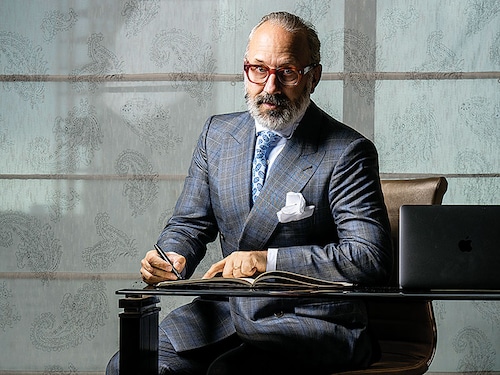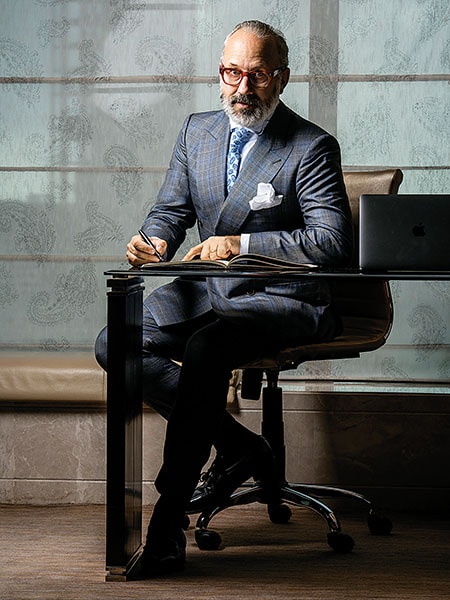The basis of our business remains tailoring: Cifonelli CEO
Erwan Camphuis talks about what keeps the Italian bespoke tailoring house relevant, and why their jacket shoulder is so special



Erwan Camphuis, CEO, Cifonelli The story of bespoke tailoring brand Cifonelli goes back four generations, with a combination of British, French and Italian techniques giving it a distinctive look.
It once prompted fashion czar Karl Lagerfeld to say, “I could recognise a Cifonelli shoulder from a distance of a hundred metres.” It’s also a style that has found favour with some of the world’s most stylish men, including Cary Grant and Fred Astaire. The brand launched in India last year, and more recently had Padmanabh Singh of Jaipur’s erstwhile royalty as the global brand ambassador for its spring/summer 2019 collection.
In an interview with Forbes India, CEO Erwan Camphuis talks about the brand’s India connect, its heritage and the luxury of having something crafted just for oneself. Edited excerpts:
Q. Cifonelli has been around for 138 years. How did it start and how has it evolved?
It has been a natural evolution around the tailoring technique. We started in Rome as a Roman tailor: Giuseppe Cifonelli. Then the second generation, Arturo, decided there were other tailors in the world with good techniques, so he went to the UK in 1911. He was then already a tailor to be a tailor takes 10 years. But he decided that to learn he had to start from scratch. He went to school and learnt for five years in the UK.
Then he worked in different workshops for another five years. Then in 1926 he decided that Paris too had a very good technique. His father was a little fed up, but he [Arturo] went to Paris and studied there for five years and then set up his first atelier at Rue Marbeuf we are still there.
So this is the only tailor in the world that has taken time to master the three biggest techniques of tailoring in the world: Italian, French and British.
Tailoring techniques have also evolved because fabrics have been evolving. In the 1940s and ’50s we were not able to do fabrics that were light. The evolution of the company is more an evolution of our tailoring and technique more than fashion. Because ultimately the tailor is not a fashion person a tailor is someone who fits people, who makes clothes for individuals, for one person after another.
Q. So what brought you to ready-to-wear?
Ready-to-wear came later into the panorama. I would say [it came] as an accessory and as a help to give our customers service in terms of shirting, ties, shoes and other components. But the basis of our business remains tailoring. We do it as a service. We don’t see it as a collection, because our customers don’t need just suits and jackets, they need also sportswear, they need pants, sports shirts… [so] we have developed a full line.
Q. How did the association with Padmanabh Singh come about?
He was a customer of ours: We had the opportunity two months ago to fit him for his birthday in Rome. He’s an extraordinarily well-dressed gentleman. We wouldn’t dare to say he is our brand ambassador. He looks very sharp in our clothes and he very happily accepted.
Q. How did your association with India come about?
We started coming regularly to India since last year, and we are very happy with the developments. We are strongly considering the possibilities of opening a lounge permanently in Mumbai. There is a natural connection with India in general because Indians have a tailoring culture. Which is not the case in some developed countries. Indian customers understand the power of a good suit or a good jacket, and that connection is natural with our product.
We have surprisingly been extremely well received. Surprisingly because we were not expecting that level of tradition and knowledge about tailoring. We have had customers ordering more than 10 suits at a time.
Q. What sets a Cifonelli jacket apart?
The shoulder is one part of it. I have to explain that it is not an aesthetic point of view it is the way it is constructed so that the jacket’s weight and fitting evolves around the shoulder and doesn’t push into the shoulder. It wraps around the shoulder and does not sit on the shoulder. This makes it very comfortable for any customer. And this is a technique exclusive to Cifonelli. So you can wear a Cifonelli jacket and you wouldn’t feel it. Which is an extraordinary sensation.
It’s also always evolving. We are finding new ways of fitting the customer better, of adapting this jacket to him. It’s not a technique that has been inherited and not touched. We always find a way to improve or adapt it better to every customer.
[qt]There is a natural connection with India in general because Indian people have a tailoring taste and a tailoring culture.”[/qt]
Q. How big a market is India for you?
We will end the year with India representing around 10 percent of our sales. I’m talking only the made-to-measure. I’m not counting the ready-to-wear turnover.
Q. What are your other exciting markets?
We are very much involved in the UK and we are opening our flagship in Clifford Street this December. The US market is still very important for us, and we are well established in Singapore and Japan.
Q. What does luxury mean to you?
Luxury for me is a feeling, more than anything else, of exclusivity, extra-ordinary sensation, and crafstmanship. You can find luxury in a lot of things, it doesn’t have to be expensive or extravagant. It has to be unique, it has to be personal to you, so that it strikes an emotion in you. It has to be unique in the fact that it has been crafted for you.
Q. What is your take on the current casualisation trend?
I think it is part of a movement that has been coming from the 1960s of making garments more comfortable. But it is not incompatible with tailoring. And it is not incompatible with our offerings. We have a lot of people asking us to do jackets or shirts for them to wear with sneakers and denim. So it’s not inconsistent. The Cifonelli jacket is all about comfort, so it is not an antinomy to us wearing a jacket and being comfortable.
Q. How do you view luxury in terms of online?
It is not so easy to sell or make a jacket online. But online first is a distribution channel it’s a way to better serve customers. Before online existed, once we had the measurements of our customers they would call us and say I want this fabric, I trust you to choose the fabric, do the measurement and I’ll send you a cheque. So, long before any digital business was done, we were already doing part of online. But this is when you have a level of confidence and comfort with customers.
Today we are launching ecommerce for ready-to-wear garments, but the relationship with the customer, the intimacy of knowing him, of advising him, of fitting him will always remain.
First Published: Oct 17, 2018, 12:04
Subscribe Now